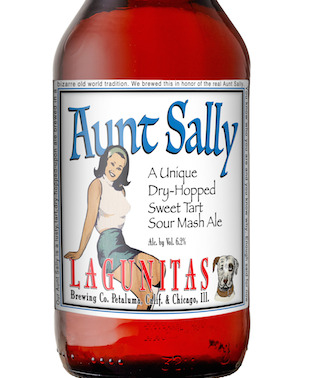Meet Lagunitas' Newest Year-Round Beer
By Ben Kramer in Food on Apr 21, 2016 1:36PM

Photo courtesy of Karen Hamilton
“If you look at our line, most of our beers don’t fall into specific guidelines, categories," Karen Hamilton, Director of Communications for the brewery, told Chicagoist. "We like to make beers we like to drink. [Beers] that are interesting to us.”
The beer, an attempt to create a "gateway sour," is translucent orange, with a light, fruity aroma. The tremendous amount of hops used in this brew—including Zeus, Cascade, and Citra hops— provide that fruitiness. As Brewmaster Jeremy Marshal explains in Lagunitas “Mouth Feels” video series, hops tend to duke it out in sour beers for flavor supremacy. As such, Aunt Sally is heavily hopped, so the hop flavor isn't overwhelmed by the sour notes, which come from Lagunitas' house strain of lactobacillus. It's not overpoweringly sour, but you can definitely taste it. At 5.7% it’s sessionable, but also a slow sipper. Could one drink it super fast? Sure, but the tartness encourages a slower, more contemplative pace.
Creating a sour didn’t come about spontaneously for Lagunitas. The Aunt Sally is the product of extensive experimentation at Lagunitas. Hamilton believes a multitude of OneHitter beers (one off’s made in their speciality OneHitter Series) where sour, tart elements were being played with served as the genesis behind Aunt Sally. She names Citrusinensis as an example; she also cited sours' growing popularity as a factor in the brew's debut.
Ultimately, to attempt a beer like Aunt Sally, and to make it an “unlimited release”, the brewery needed to feel they could do the style properly. “We were looking to get it right,” says Hamilton. After some time studying, exploring, and brewing, they feel they have done just that.